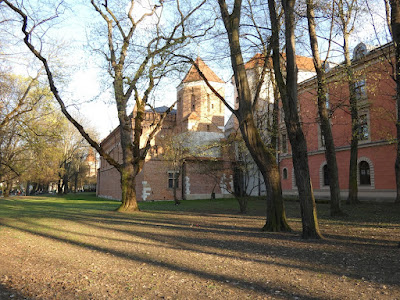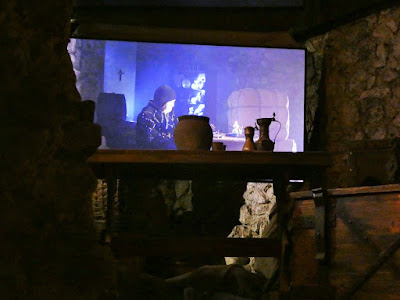.jpg) |
| Cloth Hall is the centerpiece of Rynek Glowny, Krakow's main square. |
This post is full of pictures — about twice as many as usual — thanks to the glorious spring weather my sister and I were graced with on our recent trip to Krakow. (I take much better photos when the sky is blue.) We recently spent three days exploring this beautiful city in southern Poland. Krakow was spared the destruction many European cities received in World War II because of its quick surrender to the Nazis, thus, many splendid old buildings are intact. The city boasts a huge central square, great museums, churches, a massive palace, and hearty delicious cuisine. I'll write about the most impactful part of our visit — a tour of Auschwitz and Birkenau — at the end of this post.
 |
| The trees are blooming during our early spring visit to Krakow. |
Our flight from Paris arrives early, and it's an easy train trip into the city where we have several hours to explore before we can check in to our apartment. We head to Kazimierz, the old Jewish quarter. The neighborhood is known these days for its trendy boutiques, galleries, and bars, as well as its lively nightlife.
But we're here at noon, so our minds are on lunch. We could not have found a more kitchy place than the colorful restaurant offering an array of pierogi. We nearly pass on it, but I'm charmed by the waitresses in their traditional Polish costumes. The little dumplings are delicious and extremely filling.
Kazimierz is also where you'll find Poland's oldest synagogue, the Jewish Museum, the Galicia Jewish Museum, the Remuh and New Jewish cemeteries, and several notable churches.
 |
| We pick this colorful place for lunch on our first day in Krakow. |
 |
| Usually filled with potatoes and cheese, the pierogi in Krakow are offered with an array of fillings. |
Since our backpacks are getting heavy, we head back towards our apartment, stopping for a coffee in the city's main square. Krakow's Rynek Glowny is the 40,000-square-foot centerpiece of the city's medieval Old Town. Sukiennice Cloth Hall stands in the center. Once a hub of commerce and trade, the long hall contains dozens of souvenir and craft shops. Ringing the plaza are restaurants and bars. St. Mary's Basilica is situated on the west side of the plaza, and Town Hall Tower stands at the southern end.
 |
| Town Hall Tower is the only remaining section of Krakow's 13th century town hall. |
 |
| 'The Head' is a controversial art piece located in Krakow's Main Square. |
Underneath Cloth Hall, a new museum has been created from the archaeological excavation of the plaza that began in 2005. Foundations of market stalls, workshops, and a cemetery were unearthed, along with valuable objects from the 13th-14th centuries. Instead of relocating these discoveries to a museum, the city built a museum on top of the excavation site that visitors can access via Cloth Hall. Rynek Underground Museum is fascinating, but rather confusing.
 |
| Remains of 14-th century traders' stalls are featured at Rynek Underground in Krakow. |
 |
| Films depicting life in Krakow through the centuries are shown in what were once the cellars of the Rich Stalls at Rynek Underground. |
We've scheduled a morning visit to Wawel Castle. Our stroll there takes us past several notable sites including the former home of Pope John Paul II, a beloved figure in Krakow.
 |
| This mosaic of Pope John Paul II is located at the Episcopal Palace, where he lived when he was Archbishop of Krakow. |
 |
| Twelve apostles stand in front of Saints Peter and Paul Church in Krakow. It may be Poland's oldest Baroque-style building. |
 |
| We see Sandomierska Tower on our way up Wawel Hill in Krakow. |
 |
| Tapestries from the Sigismund II Augustus collection are displayed at Wawel Castle in Krakow. |
 |
| We admire the detail of a decorative heater at Wawel Castle in Krakow. |
 |
| Krakow is relatively flat, but I find a good city view from a window at Wawel Castle. |
 |
| This gold ceiling is located in the Royal Apartments at Wawel Castle in Krakow. |
 |
| Senators Hall, also known as Dancing Hall, is the largest room in Wawel Castle in Krakow. |
 |
| The Vistula River and beyond are seen from Wawel Hill in Krakow. |
So much sightseeing means we need to power up from time to time. Polish cuisine is very hearty, but there are many options for vegetarians in Krakow too. Our apartment is a block away from Stary Kleparz market hall where we find an array of products we wish we had room in our luggage to take home. My sister does manage to fit some cottage cheese in her back pack.
 |
| Another hearty meal in Krakow is this huge potato pancake smothered with goulash. |
 |
| Stary Kleparz is a Krakow market hall filled with tempting foods. |
 |
| We show off the obwarzanek krawkowski that we made at the Krakow Bagel Museum. This popular local snack is sold on nearly every street corner. |
 |
| The Barbican in Krakow is a premier example of medieval military architecture in Europe. |
 |
| Old Town Krakow is ringed by Planty Park, a welcoming place to take a break. |
We've booked a tour of Auschwitz and Birkenau through KrakowTrip.com. The driver picks us up at our apartment just before 8 a.m., and we're joined in the van by three other couples. The drive to Auschwitz takes about an hour and a half. The parking lot is packed with tour busses and cars. We're told that around 10,000 visitors will be visiting today. It's gratifying to see so many people, the school groups in particular, who have come here to bear witness.

























